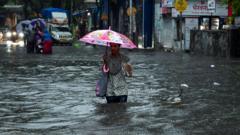Heavy rains last month caused significant turmoil in Mumbai, leading to the familiar refrain of frustration among residents asking, "Who is responsible for this mess?" With the city largely unprepared for the deluge, roads transformed into rivers, vehicles stalled, and newly constructed metro stations became inundated with muddy water. The city's already fragile infrastructure crumbled under the weight of early monsoon rains, further igniting public outrage on social media platforms. Initially, the Brihanmumbai Municipal Corporation (BMC) pointed fingers at rubbish blocking drains and debris from ongoing metro projects. In response to mounting criticism, the BMC initiated pump installations and started physically clearing waste from waterways, but for many citizens, these efforts came too little too late.
The flooding crisis is not confined to just Mumbai; it is emblematic of a broader issue affecting India's largest cities including New Delhi and Bengaluru. Each year, these urban areas face similar disasters where roads collapse, drains overflow, and traffic comes to a standstill. Experts attribute such problems to rapid, unplanned growth coupled with neglect of environmental factors and infrastructure. As Dikshu Kukreja, a prominent urban planner, points out, the pace of urbanization has outstripped the evolution of adequate water management systems.
It is noteworthy that around 80% of India's yearly rainfall occurs during the monsoon season, essential for the agricultural workforce that forms the backbone of the country's economy. However, the impacts of climate change have made weather patterns more erratic, exacerbating flooding and droughts throughout the region. An early monsoon this year caught many cities off guard, illustrating the critical need for improved planning.
In regions like Delhi, where the Minto Bridge often symbolizes annual flooding chaos, recent reports indicate record rainfall causing property damage and hazardous conditions. Meanwhile, Bengaluru faces a distinct but related challenge: urban encroachment of its original network of lakes, which served as natural flood control. Conservation advocates argue that this has drastically altered the landscape, turning areas meant for water retention into concrete jungles.
The issues go beyond major urban centers; smaller towns across India also experience life-threatening floods. Recent flooding in northeastern states resulted in tragic losses, underscoring the urgency of comprehensive disaster management. Kukreja suggests implementing advanced mapping and real-time data to predetermine at-risk zones, enhancing community awareness and engagement. However, he emphasizes that technological solutions must be paired with diligent governance and forward-thinking strategies.
To create a resilient urban environment that can withstand the monsoon chaos, India must shift its approach from reactive responses toward preventive, long-term strategies that prioritize sustainable development and infrastructure integrity.




















